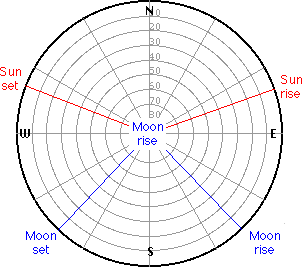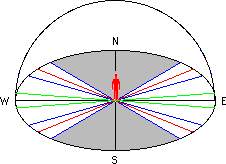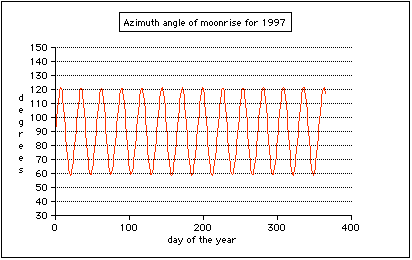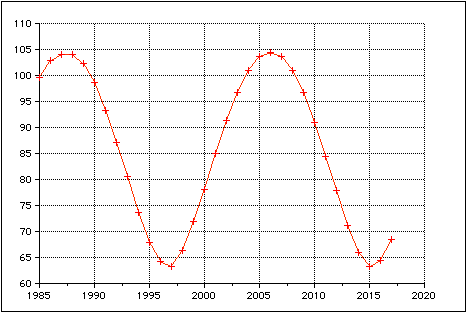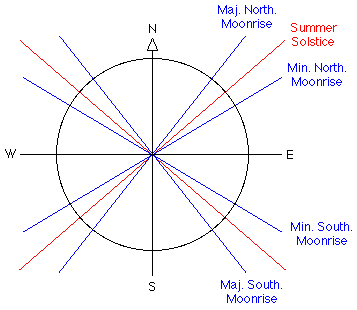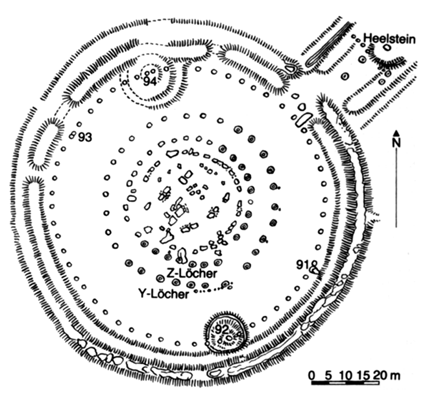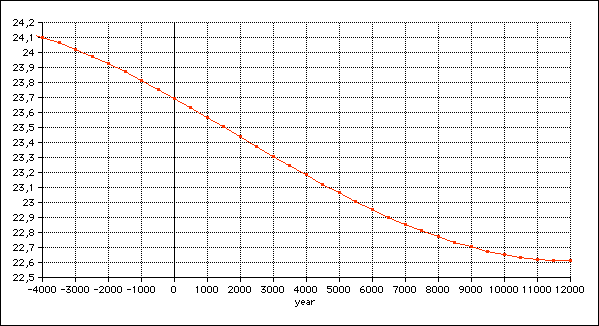|
|
GeoAstro Applets |
Astronomy |
Chaos Game |
Java |
Miscel- laneous |
Sun & Moon Polar Applet
| |
Select latitude (northern positive, southern
negative), and longitude (eastern negative, western positive) from the menus. |
|
|
You may use the keys "y", "m", "d", "h", "n" to increase the year, month, date, hour,
or minute, |
|
How to get the applet version for offline use
Watch the points (azimuth angles) of rise and set of the Sun and the Moon on the horizon as the are changing from day to day:
The azimuth angle Az0 for rise and set can be computed from the declination (delta) and the geographical latitude (beta) by: At Berlin (beta=52.51°) we get for the:
Moonrise and moonset may occur at any point of the horizon except in the grey sector: Whereas the range of the azimuth angle of rise and set is constant for the sun, it varies for the moon: 
|

Berlin, 1985 - 2017,
Major and minor northern and southern moonrise azimuth
|
In this diagram we find a period of about 18.5 years, the time for a turn of the line of nodes which rotates in the opposite direction to the Moon's movement ("regression of the nodes"). 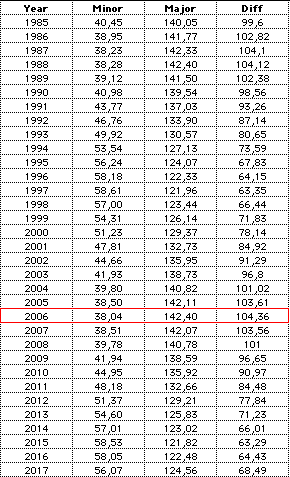
2006 is a major lunar standstill season.
The directions of solar and lunar
standstill are found at the Stonehenge observatory green: moon azimuth for declination -5.145° and
+5.145° The applet is using the simple azimuth
formula cos(Azo) = sin(delta)/cos(beta)
"Grundriss von Stonehenge. Von aussen
nach innen: Graben, Wall, Aubrey-Löcher, Quelle: Rudolf Drößler: Astronomie in
Stein. Archäologen und Astronomen enträtseln alte
Bauwerke und Kultstätten. Lizenzausgabe Panorama
Verlag, Wiesbaden, o.J., ISBN 3-926642-25-4. Seite
71, Bild 33. Obliquity of the ecliptic:
My "SunMoon Polar Applet" is calculating the sunrise/sunset (as usual in astronomy) at an altitude of -0.83°, and the moonrise/moonset at an altitude of +0.13°. The data computed by the applet were exported the the Java console and sorted by a spreadsheet program.
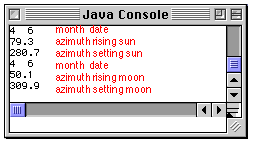
The observer is located at the centre of his "celestial sphere" with zenith Z above his head and the horizon N-E-S-W. The Sun, Moon or any other celestial body can be identified by the two coordinates altitude (elevation) h and azimuth az (horizontal coordinates). Altitude is the angular distance above the horizon (0 < h < 90°), and azimuth the angular distance, measured along the horizon, eastwards from the north point N in nautics (0 < alpha <360°), or westwards from the south point S (in astronomy). 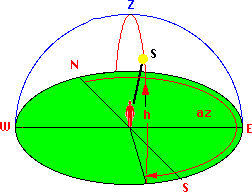
More about celestial coordinates.
|
|
|
|
|
|
Drößler, Rudolf: Astronomie in Stein.
Archäologen und Astronomen enträtseln alte Bauwerke
und Kultstätten. Krupp, Edwin C.: Astronomen, Priester,
Pyramiden. Das Abenteuer Archäoastronomie. Cornell, James: Die ersten Astronomen.
Eine Einführung in die Ursprünge der Astronomie. Michell, John: Sonne, Mond und Steine. Ein
kleiner geschichtlicher Abriss der
Astro-Archäologie. Der grüne Zweig 156. |
![]()
Please visit my
![]()
Last modified: 2023, Oct 07


